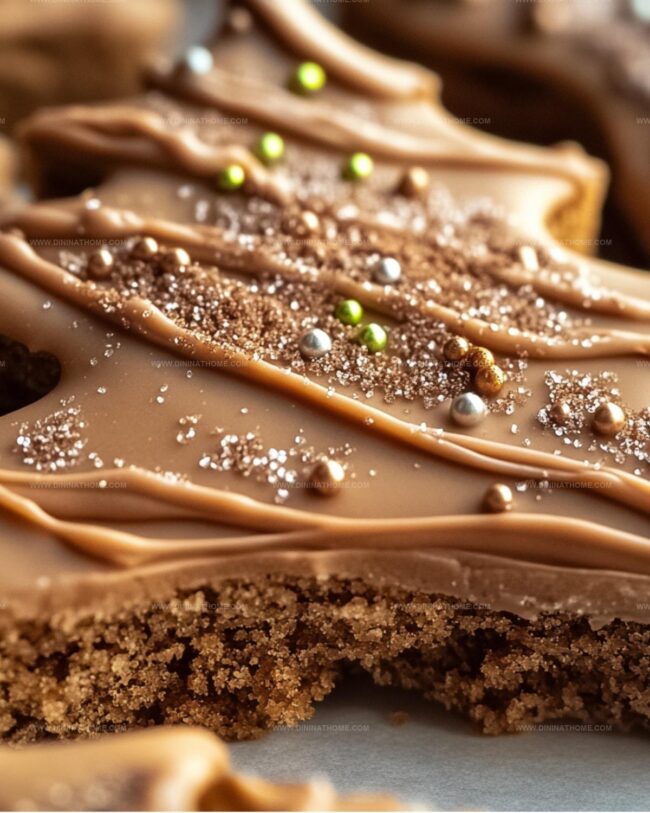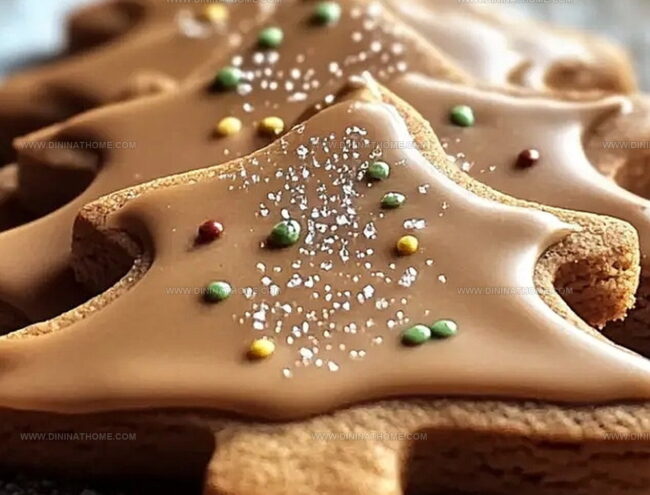Magical Gingerbread Tree Cookies Recipe: Fun Holiday Joy
Whipping up some delightful gingerbread tree cookies can turn an ordinary afternoon into a magical baking adventure.
Sweet aromas will soon fill your kitchen with warmth and nostalgia.
Delicate spices dance together, creating a symphony of flavors that whisper winter memories.
Crisp edges and soft centers promise a texture that melts right into your heart.
Decorating these festive treats becomes a playful canvas for your creativity.
Gathering loved ones around the kitchen counter makes these cookies more than just a snack, they’re a cherished moment of connection.
Why Gingerbread Tree Cookies Feel So Festive
Ingredients for Gingerbread Tree Cookies
Wet Ingredients:Dry Ingredients:Decoration Ingredients:Decorating Gingerbread Tree Cookies for Holidays
Step 1: Whip Up the Cookie Base
In a spacious mixing bowl, blend softened butter and dark brown sugar until creamy and airy.
Pour in molasses and egg, stirring until everything combines smoothly into a rich mixture.
Step 2: Mix Dry Ingredients
Grab another bowl and whisk together:Slowly incorporate dry ingredients into wet mixture, stirring until a cohesive dough emerges.
Step 3: Chill Cookie Dough
Split dough into two equal portions.
Gently press each portion into a flat disk.
Wrap each disk in plastic wrap and refrigerate for minimum 1 hour to firm up.
Step 4: Prepare Baking Station
Turn oven to 350°F.
Cover baking sheets with parchment paper, creating a perfect non-stick surface.
Step 5: Shape Festive Trees
Dust work surface with flour.
Roll out one dough disk to quarter-inch thickness.
Use tree-shaped cookie cutters to create charming holiday shapes.
Transfer cut cookies onto prepared baking sheets.
Step 6: Bake to Golden Perfection
Slide cookies into preheated oven.
Bake 8-10 minutes until edges turn golden and firm.
Let cookies rest on baking sheet for 5 minutes, then transfer to wire rack for complete cooling.
Step 7: Add Magical Decorations
Once cookies cool completely, embellish with royal icing and sprinkles, transforming them into delightful holiday treats.
Holiday Baking Smarts for Gingerbread Trees
Save Gingerbread Tree Cookies
Perfect Pairings for Gingerbread Tree Cookies
Tree Cookies Holiday Icing Variations
FAQs
Chilling helps prevent spreading during baking and allows the flour to hydrate, creating a more flavorful and structured cookie with better texture and shape retention.
While you can use salted butter, unsalted butter gives you more control over the cookie’s salt content and ensures a more consistent flavor profile in the recipe.
Roll the dough to about ¼-inch thickness to ensure even baking and maintain a soft, tender cookie texture that isn’t too crispy or too thick.
You can use alternative holiday-themed shapes like stars, snowflakes, or simple round cutters. The key is to choose cutters that allow even baking and create festive-looking cookies.
Print
Gingerbread Tree Cookies Recipe
- Total Time: 30 minutes
- Yield: 24 1x
Description
Festive holiday spirit sparkles in these charming Gingerbread Tree Cookies, blending classic spices with playful seasonal design. Delicate decorations and warm ginger notes invite winter celebrations, promising sweet memories you’ll treasure with family and friends.
Ingredients
Dry Ingredients:
- 3 cups all-purpose flour
- 1 teaspoon baking soda
- 1 teaspoon ground cinnamon
- 1 teaspoon ground ginger
- 1/2 teaspoon ground cloves
- 1/2 teaspoon ground nutmeg
- 1/2 teaspoon salt
Wet Ingredients:
- 3/4 cup (170 grams) unsalted butter, softened
- 3/4 cup dark brown sugar, packed
- 1/2 cup molasses
- 1 large egg
Decorating Ingredients:
- Royal icing
- Sprinkles
Instructions
- Blend softened butter and dark brown sugar in a spacious mixing vessel until achieving a pillowy, aerated consistency.
- Incorporate molasses and egg, stirring thoroughly until ingredients merge seamlessly.
- In a separate container, thoroughly combine flour, baking soda, aromatic spices (cinnamon, ginger, cloves, nutmeg), and salt using a whisk.
- Gradually fold dry ingredients into wet mixture, kneading gently until a cohesive dough develops.
- Partition dough into two equal portions, pressing each into a flat circular shape, then encase in plastic film.
- Refrigerate dough disks for a minimum of 60 minutes to enhance flavor and ensure optimal texture.
- Heat oven to 350°F, positioning rack in central position and lining baking trays with parchment paper.
- Dust work surface with a light flour coating and roll out initial dough disk to approximately ¼-inch thickness.
- Utilize festive tree-shaped cookie cutters to extract precise shapes, transferring delicately onto prepared baking sheets.
- Position cookies in preheated oven, baking for 8-10 minutes until edges turn firm and develop a golden-brown hue.
- Allow cookies to rest on baking sheets for five minutes to stabilize, then transfer to wire cooling rack.
- Once completely cooled, embellish with intricate royal icing and decorative sprinkles according to personal aesthetic preference.
Notes
- Chill dough longer for more intense flavor development and easier rolling.
- Use freshly ground spices to enhance the warm, rich gingerbread taste.
- Experiment with alternative flours like whole wheat or gluten-free blends for dietary variations.
- Roll dough evenly to ensure consistent baking and crisp cookie edges.
- Prep Time: 20 minutes
- Cook Time: 10 minutes
- Category: Desserts, Snacks
- Method: Baking
- Cuisine: American
Nutrition
- Serving Size: 24
- Calories: 120
- Sugar: 6g
- Sodium: 80mg
- Fat: 4.5g
- Saturated Fat: 2.5g
- Unsaturated Fat: 1.5g
- Trans Fat: 0g
- Carbohydrates: 18g
- Fiber: 0.5g
- Protein: 1g
- Cholesterol: 10mg





James Walker
Lead Recipe Developer & Culinary Educator
Expertise
Southern Cuisine & Farm-to-Table Cooking, Recipe Development & Testing, Culinary Education & Instruction
Education
School: Auguste Escoffier School of Culinary Arts
Program: Diploma in Culinary Arts and Operations
Focus: Comprehensive training in classical and modern culinary techniques, kitchen operations, and farm-to-table practices.
James didn’t learn cooking from a TV show, he learned it from busy kitchens, family gatherings, and long afternoons spent testing recipes the hard way.
After training at the Auguste Escoffier School of Culinary Arts, he brought his love for real, down-to-earth food to every dish he makes.
At Dining At Home, James loves building recipes that feel familiar but still have something special, like adding a twist to a classic or making a slow Sunday dinner feel brand new.
When he’s not in the kitchen, you’ll probably find him swapping garden tips at the farmers’ market or teaching his daughter how to flip pancakes without a mess (almost).